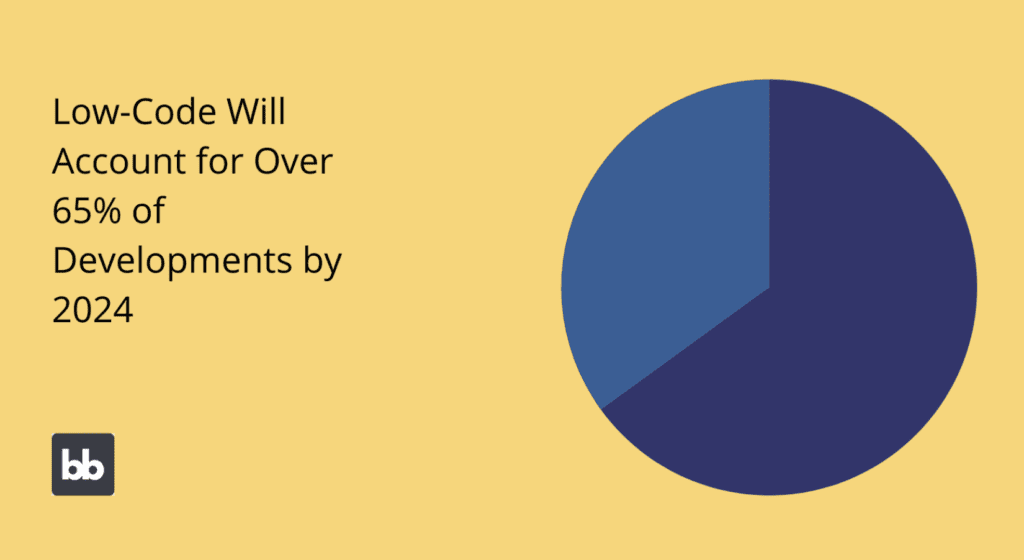Low-code application development has been experiencing explosive growth in recent years, and it’s time you learned more about it.
For as long as computers have been part of the workplace, application development has been a necessity for businesses of all kinds. So, a question on every business founder’s lips has been, how can I streamline the application development process? How can I test and validate a business idea without investing huge sums into developing software to facilitate it? How can I create an application customized to my business’s needs without relying on teams of developers, or learning to code myself?
It is a fact of the modern world that new businesses need new applications. As a company grows it will come to need technology custom-built to its uses. In the past, this has required teams of software developers to produce reams of code. It would be a costly, time-consuming process that would stunt a business’s growth. This is no longer the case and it’s thanks to low-code.
Low code puts the power to create customized, functional applications in the hands of the masses. It removes the need for high-level expertise and fluency in coding languages from the process of application development.
The technology has by no means reached its full potential, but it is already making huge waves in the tech industry and will only do so more as time goes by. So if you’re starting an app in 2023, you’re going to want to know all about it.
This article will illuminate what low-code is exactly, where it came from, its uses and limitations, and how it’s revolutionizing the world of application development.

What is Low-Code?
Low-code is a software environment that allows users to create applications without the need for huge amounts of coding. Through the use of visual interfaces, declarative programming (issuing coding instructions to an AI), and pre-built components, it enables customized applications to be made quickly, smoothly, and easily.
The low-code approach removes the complexities of traditional coding from the app development process. It lets users focus on a business idea and the functionality of an app without getting bogged down in the technical details.

The idea behind low-code development is to speed up the application development process by reducing the amount of manual coding required. In the same way, it enables people with limited programming knowledge to build functional applications. It also promotes collaboration between business users and IT teams, as it allows for rapid prototyping, iteration, and quick deployment of applications. It’s most useful for the development of simple to moderately complex applications such as internal tools, customer-facing portals, workflow applications, and mobile apps.
In simple terms, it’s software that lets people build applications without having to spend hours clacking keyboards and filling dark terminals with code.
Low-code vs. no-code
When researching you’ll often see these terms appearing together. That’s because they’re very similar and the distinction between the two can get a little blurry.
Low-code and no-code platforms are both methods of application development that don’t rely on traditional methods of coding. They are founded on the belief that technology should be available to all instead of those with expert knowledge.
The key difference is, as the names suggest, no-code relies entirely on graphical interfaces – and no coding, while low-code allows for some coding inputs in these same visual modeling environments.
What this means is that low-code platforms offer all the ease and efficiency of no-code platforms, only they offer a bit more flexibility. So, low-code can be used to achieve higher levels of complexity and customization in app development.
How does low-code work?
A low-code development platform offers a selection of pre-built components, templates, and reusable modules that users can customize and combine to create an application. Users arrange the components of the app with drag-and-drop interfaces, point-and-click configuration, and other easy-to-use visual tools. These can then be integrated with databases, APIs, and other systems, allowing developers to connect to external data sources and services without extensive coding.
In this way, users can design user interfaces, data-management systems, and business logic, and integrate various components and services into an app. Once the basic structure of the app is put together, if needs be, they can input small sections of code to fine-tune its performance or personalize it further.

What Are The Advantages of Low-Code?
Some devs, coders, and programming purists may tut and roll their eyes, but the fact of the matter is that low code is helping companies roll out new applications more quickly and easily than ever before, even for custom software development.
There are of course limitations, but if your interest is simply launching an app with an attractive landing page and functional interface, whilst making the process end-to-end as quick and as smooth as possible, low-code is more than feasible, it’s your best bet.
Here are the main reasons why low-code is more advantageous in a lot of contexts:
- It’s faster
The low-code approach vastly speeds up app development. The visual development environment with its pre-built components and templates allows users to create in an afternoon what might have taken months to develop in the past. Applications can be built more quickly, prototype and iteration cycles are faster, and changes or updates made during or after the app-testing process are quicker as well. This means apps can be deployed to markets more quickly, giving businesses a competitive edge and increasing overall productivity.
- It increases productivity
Saving the time spent coding in app development frees up time to spend on higher-value tasks. Rather than writing reams of code, developers can spend their time on the more creative aspects of design and fine-tuning user experience. Small businesses that need to build their custom app to streamline a part of their workflow can build it instantly and reap its benefits immediately. Simply put, low code reduces the grunt work, leaving more time for what matters.
- It’s more cost-efficient
Low-code development reduces development costs. First of all, a faster development process cuts costs dramatically. It also reduces the number of specialists you need to involve for things like maintenance, debugging, and troubleshooting. Finally, the faster time to market will make your app make money sooner and so improve return on investment. Even after the development process, the low-code approach will save you money. Prototyping is cheaper, the cost of maintenance is minimal, and by integrating other business tools you can automate all your data collection.
- It reduces the risk of failure
If businesses have to invest less time and money into app development, they aren’t losing as much if the business idea fails. Companies can get an app on its feet and test whether there’s a viable business idea there without ever needing to spend a penny. What’s more, prototyping and iteration cycles are much more simply implemented with low code. So, if an app isn’t performing the way it should, you’ll have more space to tweak and fine-tune the idea before abandoning it.
- It’s easier to maintain and has fewer bugs
First of all, the visual design environment of low-code platforms makes maintenance much easier. Users can switch out modules and components that aren’t working easily and without any technical knowledge. Repairs that once would have required hiring a specialist in, can now be done with a few clicks and drags. Secondly, lowering the amount of coding in app development vastly reduces the room for human error. As such, there are fewer bugs to fix in the first place.
- It bridges the IT skills gap
Low code bridges the gap between a layperson and an IT expert. It provides a middle ground where businesses and software developers can hash out their ideas speaking the same language. People often argue over which is better: custom software development or low-code? But why must the two be at odds? One of the most productive ways of using low-code platforms is in collaboration with a developer or IT specialist. Low code removes the need for overly complicated tech jargon and allows businesses to more accurately describe what they want, creating apps closer to what they envisioned.
- It democratizes application development
Low-code development empowers businesses, entrepreneurs, and creatives to make their application or at least participate more actively in the process. Non-technical users can create functional applications, reducing reliance on IT experts for every small development need and allowing them to more accurately realize their vision. It enables businesses to get an idea on its feet independently and see if there’s a viable market for it before investing too much time and money. So, it facilitates and fosters innovation within organizations and the business world.

What Are The Limitations of Low-Code?
Low-code won’t be putting developers out of a job any time soon. It will just move the problem domain and the focus of their job. They won’t be spending their time building simple apps, they’ll be helping to improve and fine-tune these simple apps or concentrating on the bigger ideas. If anything, it will help them work more efficiently.
While low-code development has many uses, traditional coding methods still have their place. For instance, if you want to launch your own SaaS platform that requires fine-grained control, performance optimization, or integration with highly specific technologies, you’ll likely still need to rely on traditional coding methods.
The suitability of low-code vs. traditional coding depends on the specific requirements and context of the project. Some of the main problem areas for low-code application development include:
- Performance limitations
Low-code platforms minimize the underlying technical complexity of app development, but this can result in less control over performance optimization. Businesses may face challenges when fine-tuning and optimizing the application, especially for resource-intensive tasks or large-scale deployments.
- Learning curve and skill requirements
While low-code development empowers non-technical developers more than ever before, there’s still a learning curve. Low-code platforms have complex features and functions that users will need to understand to fully grasp the limitations and best practices of the approach. Also, low-code still requires coding skills for some complex designs and scenarios. So, the development possibilities for non-technical users are still somewhat limited.
- Vendor lock-in
Once a user has built an application using a specific low-code platform, they’re pretty much tied into staying with that platform. Switching to another platform or technology stack would require significant effort and reworking the app, maybe from the ground up. This isn’t necessarily a problem but it does mean it’s important to carefully evaluate the long-term viability of the chosen low-code platform before committing.
- Security and compliance concerns
Haste makes waste and rapid application development may leave the door open to security risks if not done carefully. Users need to ensure they’ve taken all appropriate security measures. Using double-factor authentication, limiting authorization, and encrypting data should not be forgotten. Compliance requirements like data privacy regulations also need to be incorporated into the application development process.
- Scalability limitations
Low-code platforms have limitations for scalability especially for highly demanding or rapidly growing applications. If a business plans for large amounts of growth, it needs to carefully assess whether the chosen platform can handle increasing user loads, large datasets, or high transaction volumes. Alternatively, they’ll need to have plans in place for graduating from their low-code platform when their app exceeds its capacity.
N.B. There are ways of side-stepping this issue; platform.sh recommends WebOps platforms.
How is Low-Code Revolutionizing Application Development?

Low-code (and no-code) are a huge leap forward in the democratization of software development. They make the creation of applications more accessible and more efficient, which opens up a lot more possibilities for businesses, entrepreneurs, creatives, and other non-technical people to make their own.
If you look at the history of application development, programmers have always been looking at ways of creating more productivity. So, striving to use high-level coding languages to create software easier and faster so more people can do it.
In its most basic form, all computer programming is written in binary. However, writing everything out in 1’s and 0’s would be mind-numbingly tedious, and extremely slow, and only a few people would have the necessary skills to do it. So, coding languages were created to help make developing apps, creating software, and manipulating computers accessible to the layman.
From machine language to C, to later on Cobol and Java, it has always been a progression of more extraction and automation to make the development process smoother, more hassle-free, and more efficient. Low-code is just the next evolutionary step in this progression.
With open-source low-code platforms, app development is available to all regardless of technical expertise. This means businesses can have an idea, create an app to facilitate it, test the validity of the idea, and even open it up to public use without any knowledge of coding or needing to hire software developers. The result of this will be a more open market and a huge influx of innovations.
Who’s Using Low-Code Development Already?
So, you see low-code has been around for a while. In fact, in recent years, low-code developed apps have been popping up with the frequency of “Ask You” viruses.
For those still doubting how effective low-code can be for creating highly functional, customizable apps, it might be of interest to know what big brands are already using applications designed with low-code.
One of the most popular software for low-code app development is the Ruby on Rails platform. Here are some of the most famous sites and applications made using this software:
- Github
- Airbnb
- Shopify
- Hulu
- Dribble
- Fiver
- Funny or Die
- Basecamp
- Kickstarter
- Soundcloud

Low-Code Development: The Next Evolutionary Step
Low-code development is already booming and predictions are that it will only continue to rise. The approach still isn’t perfect and users won’t be able to achieve everything a skilled developer could with traditional coding methods. As more businesses come to use it though, it will gain more attention, more will be invested in its development, and its capacity will continue to grow.
Even now, there is a huge potential to change the way app development is done. If a business has a simple application to make, low-code allows for end-to-end development without any outside help. For the larger, more complex apps, low code is still a great way to take an idea, get it on its feet, and see if there’s a valid business prospect there.
Now that the potential for low code is starting to get noticed, you can expect to see an exponential growth of innovation in application development and for businesses to benefit hugely from this influx of new ideas. So, if your business is planning to develop an app, make sure you don’t miss the boat, and investigate low-code development.
Comments